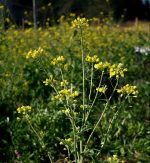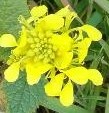 Also known as field mustard, wild mustard, and crunchweed this annual is native to the Mediterranean basin including temperate regions of North Africa, Europe, and parts of Asia. It is a member of the mustard family, Brassicaceae, that also includes broccoli, cabbage, and alyssum. A cool weather crop, wild mustard is erect, branched in its upper part, and grows 2-4 feet high on green stems that may have a purplish tinge. The upper leaves form a rosette and are ovate and 2 to 8 inches long. They have petioles 1/3-1.5″ long and uneven lobes with toothed margins. The upper leaves clasp the stem, and are unlobed and smaller as they ascend . Bright yellow flowers with four petals and measuring ¾” wide are produced in clusters at the tips of branches during the spring and early summer. Long thin seed pods 2-3 inches in length have a short thick base and long flattened beak. Each pod contains 10-18 seeds. A single plant can produce over 3,000 seeds that can persist in the soil for decades. The root system is a fibrous taproot. Charlock mustard is wide spread in North American and is considered an invasive weed in many areas. It is common in gardens, cultivated fields, pastures, roadsides, waste areas and is especial troublesome in winter small grains where it can significantly reduce yield. Although the flowers of wild mustard are a prime source of pollen and nectar for pollinating insects, the plant is an alternative host for a number of disease causing organisms that can affect vegetable crops such as broccoli, cauliflower, Brussels sprouts, and cabbage. The genus name, Sinapis, comes from the Greek word sinapi meaning mustard. The specific epithet, arvensis, is the Latin word meaning from/of the field and refers to the usual habitat of the plant.
Also known as field mustard, wild mustard, and crunchweed this annual is native to the Mediterranean basin including temperate regions of North Africa, Europe, and parts of Asia. It is a member of the mustard family, Brassicaceae, that also includes broccoli, cabbage, and alyssum. A cool weather crop, wild mustard is erect, branched in its upper part, and grows 2-4 feet high on green stems that may have a purplish tinge. The upper leaves form a rosette and are ovate and 2 to 8 inches long. They have petioles 1/3-1.5″ long and uneven lobes with toothed margins. The upper leaves clasp the stem, and are unlobed and smaller as they ascend . Bright yellow flowers with four petals and measuring ¾” wide are produced in clusters at the tips of branches during the spring and early summer. Long thin seed pods 2-3 inches in length have a short thick base and long flattened beak. Each pod contains 10-18 seeds. A single plant can produce over 3,000 seeds that can persist in the soil for decades. The root system is a fibrous taproot. Charlock mustard is wide spread in North American and is considered an invasive weed in many areas. It is common in gardens, cultivated fields, pastures, roadsides, waste areas and is especial troublesome in winter small grains where it can significantly reduce yield. Although the flowers of wild mustard are a prime source of pollen and nectar for pollinating insects, the plant is an alternative host for a number of disease causing organisms that can affect vegetable crops such as broccoli, cauliflower, Brussels sprouts, and cabbage. The genus name, Sinapis, comes from the Greek word sinapi meaning mustard. The specific epithet, arvensis, is the Latin word meaning from/of the field and refers to the usual habitat of the plant.

Type: Annual
Bloom: Terminal clusters of yellow flowers with 4 petals from late spring to early summer
Size: 2-5′ H
Light: Full sun but tolerates some shade
Soil: Fertile, medium moist, well-drained but tolerates many soil types
Hardiness: Not applicable
Care: Because of the invasive and weedy nature of the plant control measures important.
Pests and Diseases: Many diseases and pests including leaf spot, fusarium wilt, verticillium wilt, aster yellows, Alternaria
Propagation: Seed
Companion Plants: Not applicable
Photo Credits: Wikipedia